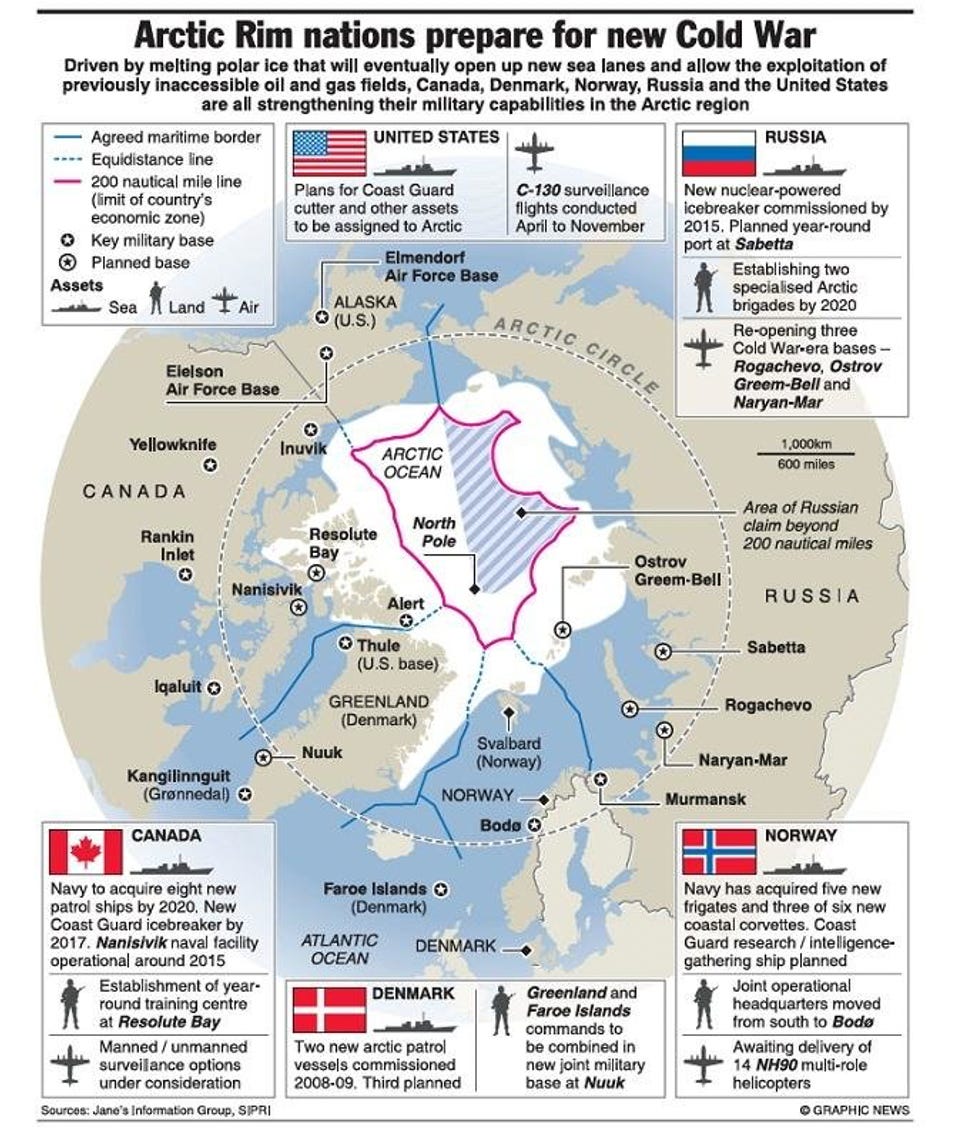The High North
The world looks very different when viewed from the North Pole.
We see the Finns moving their tractors to the border with Russia and banning all vehicles with Russian license plates. We see the Prince Haakon of Norway, visiting Kirkenes, the town that borders Russia, trying to calm relations between the two sides while the Norwegian authorities quietly arrest Russian spies that are seemingly trying to foment trouble there. Islands from the Baltic Sea to the Barents Sea are being shored up and protected from a possible Russian threat with the intent to take possession of them. They include places that were well-known strategic locations in WWII but which hardly anyone remembers today like Bear Island and Jan Mayen Island, where the British Navy’s HMS Prince of Wales recently made a very rare stop. President Zelenskyy has suddenly warned Swedish Parliament about a potential Russian occupation of Gotland, their Baltic Straight island. He said, “Russia has started discussing how to occupy Gotland, your island.” Meanwhile, the Danish Prime Minister, Mette Frederiksen, told Russia’s Ambassador to stay out of Denmark’s efforts to get American soldiers assigned to Bornholm Island, which also sits in the Baltic Straights. The Russian Ambassador, Vladimir Barbin, had said that this would not be permitted under the current arrangements between Denmark and Russia dating from the end of WWII, implying that Denmark would face consequences if they proceeded. In fact, Russia has now more than suggested that Finland and Sweden will face a nuclear threat from Russia’s new Khinzal hypersonic missiles if they join NATO. Lithuania’s President shrugged off that threat, pointing out that nuclear weapons are already positioned. But the Lithuanian Rifleman’s Union is definitely preparing for the worst, particularly any Russian move on the vulnerable Suwalki Gap. The Estonian Defence League is doing the same. Meanwhile, the British Defence Minister formally announced the establishment of a “High North Strategy” to deal with all this.
All this prompted the leaders of Poland the Baltic states to make a pilgrimage to Kyiv this week. This was not just to pay their respects or provide support. The Baltics, in particular, understand very well that they are a target for military action by Russia. This goes beyond the risk that Russia somehow manages to wrest control of the Suwalki Gap, thus connecting Kaliningrad and Belarus, a step that would leave the Baltic states fully surrounded on all sides. Russia already has nuclear weapons in Kaliningrad and probably in Belarus too. They certainly have them on the submarines in the Baltic and Northern Fleets. These are not simply tactical nukes. Russia’s Yuri Dolgoruky “can deliver the firepower of 640 Hiroshima’s in less than a minute” according to Popular Mechanics and that was in 2018. Substantial technological advances have obviously occurred since then. Even if most of Russia’s nuclear capability is not up to scratch, it is a threat everyone in the North of Europe now takes seriously.
It is not just a missile launch that they fear. Norway is concerned that Russia can far outgun them in the remote island chains like Svalbard and the tiny but strategically crucial Bear Island. They also worry that Russia might not launch a nuclear missile but rather simply allow nuclear waste to leak into the pristine Norwegian wilderness. The Norwegians are well aware that Russia has deliberately targeted the largest nuclear power plants in Ukraine, Chornobyl, and Zaporizhzhia, shelling them and depriving them of power thus raising the risk of a nuclear accident. This nuclear terrorism threatens all Northern nations, and of course the whole planet. But the Norwegians also know that Russia also has some of the largest nuclear waste dumps in the world operating near Norway. For decades the Norwegian Radiation Safety Authority has collaborated with Russia to manage the spent nuclear material emanating from Russia’s military. Today, a new Iron Curtain has descended between Russia and Norway which means that the dialogue has stopped and the inspectors and scientists are no longer able to cross the border at Kirkenes. The risk is rising that the Russians either inadvertently or deliberately cause spent nuclear waste to impact Norway.
Only a week ago Crown Prince Haakon of Norway personally went to visit the border town between Russia and Norway, Kirkenes, to try to keep good relations going. Kirkenes has long been a critical point of contact between Russia and the West, especially throughout the Cold War. It was one of only two places where people could pass back and forth between The Soviet Union and The West. The Germans took control of it in 1941 which caused it to become one of the most bombed locations in the 2nd World War. When the Soviets liberated Kirkenes from the Germans, they built a statue of the unknown Russian soldier.
So, it is worth noting that the Russian Ambassador to Norway and a local Consul crossed into Norway to celebrate that liberation, the Day of the Defenders of the Fatherland, on the very same day that Russia’s invasion into Ukraine commenced. The Russian officials left flowers at that statue of Russian soldiers. This holiday is usually only honored inside Russia and Belarus, but not outside Russia. Was this official act on that day perhaps a signal of things to come?






